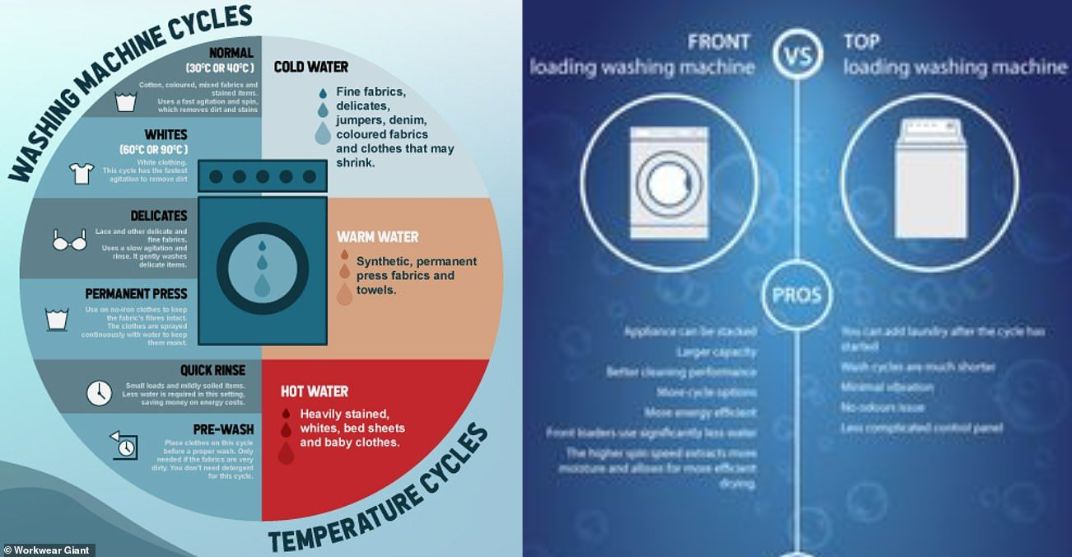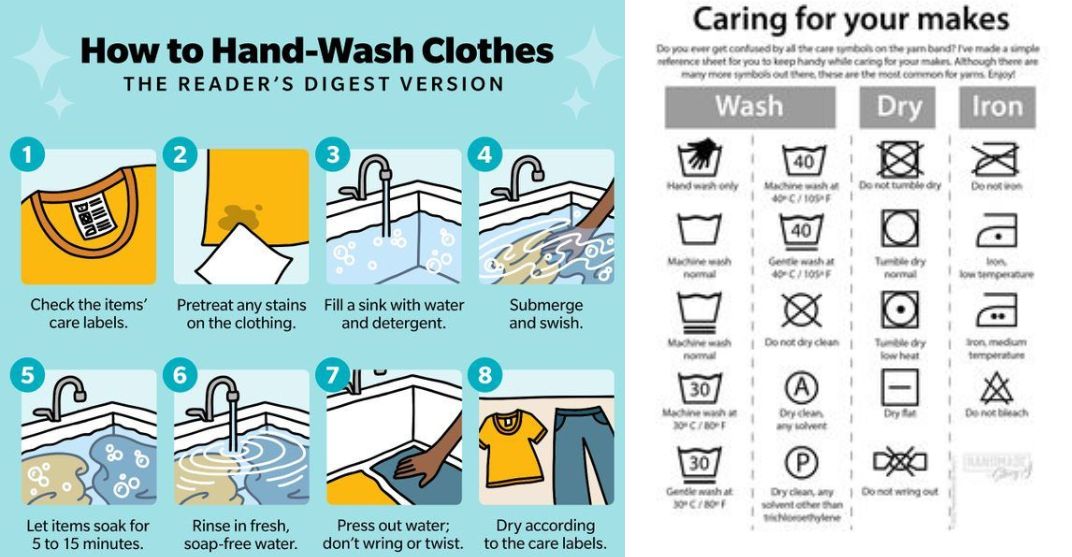
Have you ever pulled your favorite T-shirt out of the dryer only to find it shrunken, faded, or stretched out? Or your go-to hoodie lost its softness after just a few washes. Proper clothing care isn’t just about looking good—it’s about making your wardrobe last longer, saving money, and reducing fashion waste.
From T-shirts, polo shirts, and sweatshirts to jackets and joggers, every piece in your closet deserves the right care. The good news? With a few simple changes to how you wash, dry, and store your clothes, you can keep them looking fresh for years.
This guide will break down expert tips on laundry care, stain removal, and sustainable practices to help you get the most out of your wardrobe. Let’s dive in and make your clothes last longer!
1. Read the Care Labels: The Key to Longevity
Every piece of clothing—whether it’s a T-shirt, polo shirt, hoodie, sweatshirt, jacket, or pair of pants—comes with a care label that provides essential washing and drying instructions. Ignoring these can lead to fading, shrinkage, stretching, or fabric damage. If you want your favorite outfits to last, reading and following these care labels is non-negotiable.
Understanding Common Laundry Symbols
Laundry symbols might look confusing at first, but once you understand them, you’ll know exactly how to take care of different types of clothing. Here’s a quick guide to the most important symbols and what they mean:
Machine Wash:

A bucket symbol with water means the item can be washed in a machine. The number inside indicates the maximum water temperature (e.g., “30” means wash at 30°C).
Hand Wash Only:

A hand inside the bucket means the item should be hand-washed gently in cold water to prevent damage. This applies to delicate fabrics like silk, lace, and wool sweaters.
Do Not Bleach:
A triangle with an “X” means no bleach should be used, as it can weaken fabric fibers, cause discoloration, or ruin prints and logos. This is especially important for colored T-shirts, graphic tees, and printed hoodies.
Tumble Dry Low:
A square with a circle inside indicates the item is safe for the dryer, but the dots inside the circle determine the heat level. One dot = low heat, two dots = medium heat, three dots = high heat. High heat can shrink cotton shirts, fade sweatpants, and damage elastic in activewear.
Do Not Tumble Dry:
A square with a circle and a big “X” over it means the item should never go in the dryer. Clothes like wool sweaters, performance shirts, and polyester sportswear are best air-dried to maintain their shape and performance properties.
Ironing Instructions:
An iron symbol with dots represents the recommended temperature setting:
- One dot – Low heat for delicate fabrics like silk and polyester
- Two dots – Medium heat for cotton dress shirts, polo shirts, and twill pants
- Three dots – High heat for linen and heavy cotton fabrics
- “X” over the iron – Do not iron! (Common for screen-printed T-shirts and jackets with synthetic materials)
Dry Clean Only:
A circle with a letter inside (P or F) means the item must be professionally dry-cleaned. This applies to suits, coats, and structured outerwear that can lose their form in a washing machine.
Why Ignoring Care Labels Can Ruin Your Clothes
Skipping these instructions can lead to ruined garments and wasted money. Here are some common mistakes and their consequences:
- Washing a wool sweater in hot water → Causes shrinkage, turning it two sizes smaller!
- Putting a polyester jacket in the dryer on high heat → Leads to melting or permanent wrinkles.
- Ironing a printed T-shirt on high heat → Fades the design or causes it to peel off.
Using bleach on a dark-colored hoodie → Causes discoloration and weakens fabric fibers.
Pro Tip: If you cut off the care label, take a picture of it first! That way, you can always reference the instructions when washing.
2. Best Washing Practices for Long-Lasting Clothes
Washing your clothes the wrong way is one of the fastest ways to ruin fabrics, causing fading, shrinking, stretching, or even tearing. Whether you’re washing T-shirts, polo shirts, hoodies, sweatpants, jackets, or performance wear, following proper washing techniques can help them last much longer.
Sort Your Clothes Properly
Sorting your laundry correctly prevents color bleeding, fabric damage, and pilling. Here’s how you should separate your clothes before washing them:
- Sort by color – Always wash whites, darks, and bright colors separately to prevent dye transfer.
- Sort by fabric type – Washing delicate fabrics (silk, lace, satin) with heavy fabrics like denim or towels can cause tears and abrasions.
- Sort by washing temperature – Some fabrics require cold water, while others need warm or hot water to clean properly.
- Check for stains – Pretreat oil, ink, and sweat stains before washing so they don’t set into the fabric.
Pro Tip:
Turn dark-colored clothes (black hoodies, maroon T-shirts, dark jeans) inside out before washing to reduce fading.
Fasten zippers and buttons on jackets, pants, and dress shirts to prevent snagging.
Choosing the Right Detergent
Using the wrong detergent can cause fading, wear-out fibers, or leave residue on your clothes. Choose the right detergent based on your fabric type:
- Mild detergent for delicates – Silk, wool, and lace need gentle, pH-balanced detergents to maintain softness.
- Heavy-duty detergent for cotton and polyester – Everyday clothes like T-shirts, polo shirts, and sweatpants need detergents that can remove dirt without damaging fibers.
- Sports-specific detergent for activewear – Performance fabrics and workout clothes require enzyme-based detergents that remove sweat and odor without breaking down elasticity.
- Fragrance-free detergent for sensitive skin – If you have skin allergies, avoid detergents with harsh chemicals, dyes, or artificial fragrances.
Cold Water vs. Warm Water vs. Hot Water: Which One to Use?
Water temperature plays a big role in how well your clothes hold up over time. Using the right temperature prevents shrinkage, fading, and fabric wear.
Cold water (30°C or below) – Best for:
- Delicate fabrics (silk, satin, lace)
- Bright colors (red, yellow, blue)
- Activewear and performance shirts
- Clothes prone to shrinking (wool, rayon)
Warm water (30-40°C) – Best for:
- Cotton T-shirts, polo shirts, and dress shirts
- Polyester blends and twill shirts
- Everyday wear like sweatshirts and joggers
- Synthetic and mixed-fabric clothes
Hot water (50°C and above) – Best for:
- Towels, bedsheets, and undergarments
- Heavily soiled work clothes and uniforms
- Kitchen rags and dishcloths
Pro Tip:
If you’re unsure, use cold water! It prevents shrinkage, fading, and fabric weakening.
Hand Washing vs. Machine Washing: When to Choose Which?
Some clothes should never be thrown into a washing machine because they can lose their shape, stretch, or get damaged.
Hand wash delicate fabrics like:
- Silk and satin dress shirts
- Lace tops and lingerie
- Cashmere sweaters
- Embroidered or beaded outfits
Use a gentle cycle in the washing machine for:
- Lightweight T-shirts and polo shirts
- Sweatshirts and hoodies made of cotton blends.
- Performance fabrics and gym wear
- Dress shirts and blouses
Washing Tips for Longer-Lasting Clothes
- Wash clothes less frequently—overwashing can wear out fibers faster.
- Use the right detergent and temperature for each fabric.
- Turn clothes inside out to preserve color and prints.
- Hand wash delicate fabrics and use a gentle cycle for lightweight materials.
- Air-dry whenever possible to avoid dryer damage (more on that in the next section!).
By following these washing techniques, you’ll keep your favorite clothes looking fresh, soft, and durable for years to come. Next, let’s talk about the best drying methods!
3. The Right Way to Dry Clothes
Drying your clothes correctly is just as important as washing them properly. Overusing the dryer can cause shrinkage, fading, and fabric damage, while improper air drying can lead to wrinkles, mildew, or stretched-out clothes.
If you want your T-shirts, hoodies, jackets, sweatpants, polo shirts, and delicate fabrics to stay in great condition for years, follow these expert drying techniques.
Why Air Drying is Better Than Machine Drying
Air drying is the safest, most sustainable way to dry clothes. Here’s why you should skip the dryer whenever possible:
- Prevents shrinkage and fading – High heat breaks down fibers, causing clothes to shrink, fade, or lose elasticity.
- Keeps fabrics soft and intact – Heat can make cotton, wool, and polyester stiff and brittle over time.
- Reduces energy consumption – Dryers consume a lot of electricity, so air drying is an eco-friendly option.
- Less wear and tear – The constant tumbling in the dryer weakens fabric fibers, leading to holes, pilling, and fraying.
- Saves money – Since air drying doesn’t cost a thing, you’ll save on electric bills and replacement clothing.
Pro Tip:
Avoid drying clothes in direct sunlight for extended periods—UV rays can cause fading, especially on black, red, and dark-colored clothing.
Best Drying Methods for Different Fabrics
Different fabrics require different drying methods to prevent damage. Here’s how to dry your clothes the right way:
Hanging – Best for:
- T-shirts, polo shirts, button-up shirts
- Dresses and lightweight tops
- Synthetic fabrics like polyester and spandex
Flat drying – Best for:
- Knitwear, sweaters, and wool clothing (prevents stretching)
- Delicate lace tops and embroidered pieces
- Silk blouses and cashmere garments
Tumble dry on low heat – Best for:
- Cotton T-shirts and sweatpants
- Denim jeans and jackets (prevents stiffness)
- Towels, bed linens, and cotton socks
How to Air Dry Clothes Properly
If you’re air-drying clothes indoors or outdoors, follow these tips to keep them in the best shape:
- Use a drying rack or clothesline – Prevents clothes from becoming wrinkled or misshapen.
- Shake out clothes before hanging – Reduces wrinkles and drying time.
- Lay heavy items flat – Knitwear, wool, and delicate fabrics stretch when hung up, so dry them flat on a towel.
- Ensure proper airflow – Hang clothes in a well-ventilated area to prevent mildew and musty odors.
Pro Tip:
Hang shirts and T-shirts on wooden or padded hangers to help maintain their shape. Avoid metal hangers, as they can rust and stain clothes.
How to Machine Dry Clothes Without Damage
While air drying is ideal, sometimes you need to use a dryer. Here’s how to prevent damage when using a machine dryer:
- Use the lowest heat setting – High heat causes shrinking and fading, so opt for tumble dry low whenever possible.
- Remove clothes while slightly damp – This reduces wrinkles and prevents over-drying, which can make fabrics stiff.
- Use dryer balls instead of fabric softener – Wool dryer balls reduce static cling and drying time without coating clothes in chemicals.
- Don’t overload the dryer – Clothes need space to tumble freely for even drying.
Pro Tip:
Skip the dryer for activewear and elastic fabrics! Heat breaks down spandex and elastane, causing leggings, joggers, and workout shirts to lose their stretch.
Drying Tips for Long-Lasting Clothes
- Air dry whenever possible – It’s the best way to extend fabric life.
- Use a drying rack or clothesline to prevent wrinkles and stretching.
- Lay heavy garments flat to avoid misshaping and stretching.
- Tumble dry on low heat if needed, and remove clothes while slightly damp.
- Avoid over-drying to prevent fabric stiffness and wear.
4. Ironing vs. Steaming: Which is Better?
Wrinkled clothes can make even the most stylish outfit look messy and unpolished. But when it comes to removing wrinkles, should you iron or steam? The right method depends on the fabric type, level of wrinkles, and how much time you have. Let’s break it down.
When to Choose Ironing vs. Steaming
Ironing is better for:
- Cotton and linen shirts, pants, and dress shirts – Direct heat smooths out deep creases
- Sharp, structured looks – Great for business shirts, uniforms, and pleated pants.
- Stubborn wrinkles – The hot iron presses out even the toughest wrinkles.
Steaming is better for:
- Silk, polyester, chiffon, and satin – Prevents fabric from burning or getting shiny marks.
- Delicate fabrics – Safe for lace, wool, cashmere, and beaded garments.
- Suits, jackets, and coats – Helps refresh fabric without flattening its structure.
- Quick touch-ups – No need for an ironing board; perfect for last-minute fixes!
Pro Tip:
Use steam to freshen up clothes between washes! A quick steam session can eliminate odors and reduce bacteria without washing.
Ironing & Steaming Tips for Long-Lasting Clothes
- Use the right heat setting – Prevents burns, shine marks, and damage.
- Test a small area first – Especially for delicate or synthetic fabrics.
- Use distilled water in your steamer – Prevents mineral buildup that can stain clothes.
- Don’t iron directly overprints or logos – Use a pressing cloth to avoid ruining graphics.
- Store your iron & steamer properly – Empty leftover water to prevent leaks.
Which One Should You Use?
For deep wrinkles and structured clothing? → Ironing
For delicate fabrics and a quick refresh? → Steaming
For best results? → Use both! Iron-structured areas (like collars and cuffs) and steam the rest.
By choosing the right method, your shirts, pants, hoodies, jackets, and delicate fabrics will stay looking fresh and polished for years to come!
Next, let’s talk about proper clothing storage to prevent wrinkles and damage!
5. Stain Removal Hacks: Save Your Favorite Clothes
Act fast! The sooner you treat a stain, the higher the chances of removing it completely. Different stains require different treatments, so knowing the right method can help you rescue your favorite T-shirts, pants, polo shirts, hoodies, jackets, and more from permanent damage.
General Stain Removal Rules
- Blot, don’t rub! – Rubbing pushes stains deeper into fabric fibers.
- Cold water first! – Hot water can set stains like blood, coffee, and wine.
- Work from the outside in! – Prevents the stain from spreading further.
- Test before using chemicals! – Always test a small hidden area first.
- Check before drying! – Heat sets stains, so make sure it’s gone before using a dryer.
Tough Stains? Try Oxygen Bleach!
Instead of harsh chlorine bleach, use oxygen bleach (like OxiClean) for brightening clothes without weakening the fabric.
Safe for whites & colors
Works on old & stubborn stains
Won’t damage fabrics like chlorine bleach
How to Use It:
Mix 1 scoop of oxygen bleach + warm water in a bucket.
Soak stained clothes for 1-6 hours.
Wash as usual.
Stain Removal Tips
- Avoid the dryer until the stain is gone – Heat sets stains permanently!
- For delicate fabrics (silk, wool, lace), test first – Some chemicals may damage them.
- Always wash with similar colors – Stain removers can sometimes fade the fabric.
- Keep a stain-removal pen handy – Great for on-the-go emergencies!
By following these hacks, your shirts, pants, polo shirts, hoodies, jackets, and more will stay fresh and stain-free for years!
6. Smart Storage Tips to Prevent Damage
Proper storage is essential for keeping your clothes, puffer jackets, performance hoodies, polo shirts, pocket T-shirts, and cargo pants in top condition. Storing your clothing the wrong way can lead to wrinkles, stretching, fading, or even pest damage. Here’s how to store your wardrobe like a pro!
Fold vs. Hang: What’s Best for Each Type of Clothing?
Fold These Clothes (Prevents stretching & maintains fabric quality)
- Sweaters & Knitwear – Hanging stretches them out. Fold instead.
- T-shirts & Casual Tops – Keeps shape and avoids hanger bumps.
- Denim & Pants – Folding is better for non-crease-prone pants like jeans.
- Delicates (Lace, Silk, Embellished Fabrics) – Prevents snags and stretching.
Hang These Clothes (Prevents creasing & maintains structure)
- Jackets & Coats – Heavy outerwear keeps its form when hung properly.
- Dress Shirts & Blouses – Reduces wrinkles, making ironing easier.
- Polo Shirts & Button-Ups – Helps maintain the collar shape.
- Dresses & Skirts – Prevents creases and keeps fabrics flowing.
- Suit Jackets & Blazers – Needs structured hangers to maintain their silhouette.
Pro Tip: Use padded or wooden hangers for delicate fabrics and structured clothing to avoid shoulder bumps.
Best Storage Solutions to Keep Clothes Fresh & Damage-Free
Use the Right Hangers
- Wooden Hangers – Ideal for coats, blazers, and structured clothing.
- Velvet Hangers – Prevent silk and delicate fabrics from slipping.
- Padded Hangers – Best for fragile fabrics like lace and satin.
- Clip Hangers – Great for skirts and pants to avoid creases.
Protect Seasonal Clothes with Vacuum-Sealed Bags
- Great for storing bulky sweaters, coats, and off-season clothes.
- Saves space in your closet while keeping dust and moisture out.
- Keep away from delicate fabrics like wool or silk (compression can weaken fibers).
Pro Tip: For wool and cashmere, use breathable fabric bags instead of plastic.
Avoid Moth Damage with Natural Repellents
Wool, cashmere, and silk attract moths, which can create holes in your favorite sweaters and coats. Instead of using chemical mothballs (which have a strong odor and toxins), try these natural alternatives:
- Cedar Blocks or Sachets – Repel moths while adding a fresh scent.
- Lavender Pouches – A natural moth deterrent that smells amazing.
- Cloves & Bay Leaves – Place in small fabric bags to keep pests away.
Keep Shoes & Accessories Organized
- Shoe Racks – Prevent shoes from getting crushed and help air circulation.
- Storage Bins for Accessories – Use labeled bins for belts, scarves, and gloves.
- Drawer Organizers – Perfect for socks, underwear, and smaller items.
Pro Tip: Stuff shoes with tissue paper to maintain their shape, especially for boots!
Breathable Garment Bags for Formal Wear
- Use cotton or canvas garment bags (not plastic) for suits, gowns, and delicate fabrics.
- Plastic traps moisture, which can cause mildew and odors.
- Hang formalwear in a cool, dry place to prevent wrinkles and discoloration.
Maintain Proper Closet Conditions
- Keep humidity levels low – Moisture can cause mildew and odors. Use silica gel packets or charcoal dehumidifiers inside your closet.
- Rotate seasonal clothing – Store out-of-season clothes separately to avoid overcrowding.
- Leave space between hanging clothes – Prevents wrinkles and allows air circulation.
Store Clothes in Cool, Dark Places
- Sunlight fades fabric colors, so store clothing away from direct light.
- Closets should be dry and well-ventilated to prevent mildew.
- Use scented sachets (lavender, eucalyptus) to keep clothes smelling fresh.
Pro Tip: If you store clothes in plastic bins, choose clear ones so you can see what’s inside without rummaging through everything. By following these smart storage tips, you can prevent damage, avoid wrinkles, and extend the lifespan of your favorite clothes—from T-shirts and polo shirts to jackets and outerwear!
7. Special Care for Different Fabrics
Taking proper care of different fabric types ensures longevity, maintains color vibrancy, and preserves texture. Here’s how to care for specific materials:
Wool & Cashmere Care
- Hand wash wool sweaters and cashmere garments using a gentle wool-safe detergent to prevent shrinking.
- Always lay wool and cashmere flat to dry to maintain their shape.
- Store with moth-repellent sachets to avoid fabric damage.
Silk & Satin Fabric Care
- Avoid water spots on silk and satin fabrics by steaming instead of ironing.
- Hand wash delicate silk dresses and satin shirts using cold water and mild detergent.
- Always store silk blouses, satin skirts, and evening wear in breathable garment bags to prevent snags.
Denim Maintenance Tips
- Wash denim jeans inside out to maintain the original color and prevent fading.
- Reduce wear and tear by washing denim jackets, jeans, and skirts only after 5-10 wears.
- Use mild detergent for denim pants to keep the fabric strong and comfortable.
Activewear & Performance Fabric Care
- Avoid fabric softeners on activewear shirts, leggings, and shorts as they trap sweat and odors.
- Use a moisture-wicking detergent when washing performance t-shirts, gym wear, and compression gear to maintain breathability.
- Air-dry workout clothes, yoga leggings, and sports bras to preserve elasticity.
Leather Clothing & Accessories Care
- Use a leather conditioner to prevent cracking on leather jackets, bags, and boots.
- Store genuine leather coats and accessories in a cool, dry place to avoid moisture damage.
- Clean suede and nubuck leather with a dedicated brush to maintain their texture.
By following these fabric care tips, you can extend the life of your fashion staples, keep colors vibrant, and maintain fabric quality over time.
8. Overwashing Can Ruin Your Clothes
Frequent washing can fade colors, weaken fibers, and shrink fabrics, reducing the lifespan of your favorite outfits. Instead of overwashing, use these fabric-friendly alternatives to keep clothes fresh:
How to Refresh Clothes Without Washing
Air Clothes Out After Wearing
- Hang cotton t-shirts, hoodies, and denim jeans in a well-ventilated area to remove odors naturally.
- Let performance shirts, gym wear, and activewear breathe after workouts to prevent sweat buildup.
- Use a garment steamer to eliminate wrinkles and refresh delicate fabrics like silk, satin, and wool sweaters.
Use Fabric Refresher Sprays with Essential Oils
- Spritz linen shirts, dress shirts, and polyester blend tops with a fabric refresher spray to maintain a just-washed scent.
- Choose lavender, eucalyptus, or citrus-infused sprays to neutralize odors without harsh chemicals.
- DIY a fabric freshener mist by mixing water, white vinegar, and essential oils in a spray bottle.
Spot Clean Minor Stains
- Dab food stains on cotton t-shirts and sweatpants with a damp cloth and mild detergent instead of washing the entire garment.
- Use a stain remover pen for quick fixes on dress shirts, denim jackets, and pants.
- Treat oil stains on polyester shirts and performance fabrics with baking soda before a full wash.
By reducing unnecessary washes, you can preserve the quality of your clothes, maintain color vibrancy, and extend fabric durability while being eco-friendly.
9. Sustainable Clothing Care Practices
Caring for your clothes in an eco-friendly way helps reduce environmental impact while preserving fabric quality. Follow these sustainable laundry tips to keep your wardrobe fresh and long-lasting:
Use Plant-Based Laundry Detergents
- Choose biodegradable, non-toxic detergents made from natural ingredients to protect both fabrics and the planet.
- Look for phosphate-free, dye-free, and cruelty-free laundry soaps that work on cotton t-shirts, activewear, and delicate fabrics.
- Brands offering organic laundry detergents ensure gentle cleaning without harsh chemicals.
DIY Fabric Softener for Chemical-Free Laundry
- Replace commercial fabric softeners with a DIY alternative by mixing white vinegar and essential oils (like lavender, lemon, or eucalyptus).
- This natural fabric softener helps remove residue from performance shirts, workout clothes, and soft cotton hoodies while keeping them fresh.
- Vinegar also helps reduce static in polyester blends, fleece pants, and synthetic fabrics.
Cold Wash to Save Energy & Protect Fabrics
- Washing clothes in cold water prevents color fading, fabric shrinkage, and fiber damage while using less energy.
- Cold washing is ideal for graphic t-shirts, screen-printed apparel, and custom clothing to preserve designs.
- It also extends the lifespan of denim jeans, moisture-wicking activewear, and non-iron dress shirts.
By adopting these sustainable laundry habits, you can reduce your carbon footprint, prolong the life of your clothes, and support a greener, more ethical fashion industry.
Conclusion: Take Action for Longer-Lasting Clothes
Your wardrobe deserves the best care! By following these expert clothing care tips, you can extend the lifespan of your clothes, keep fabrics looking fresh, and save money—all while reducing waste and making sustainable choices.
Small changes, like washing with eco-friendly detergents, air-drying instead of machine drying, and spot-cleaning stains, can have a big impact on your clothing’s durability. Not only will your favorite t-shirts, jeans, and performance wear last longer, but you’ll also contribute to a greener planet.
Ready to level up your laundry game? Start today and share these clothing care hacks with friends!
FAQs:
Q1: How do I stop my clothes from fading?
Wash inside out, use cold water, and avoid harsh detergents.
Q2: How often should I wash jeans?
Every 5-10 wears to prevent shrinkage and fading.
Q3: Can I use vinegar instead of fabric softener?
Yes! White vinegar naturally softens the fabric and removes odors.
Q4: What’s the best way to store winter clothes?
Vacuum-sealed bags or breathable fabric bins keep clothes fresh.
Q5: How can I make my clothes smell fresh without washing?
Hang them outside or use a fabric refresher spray with essential oils.
Published on:
April 3, 2025





